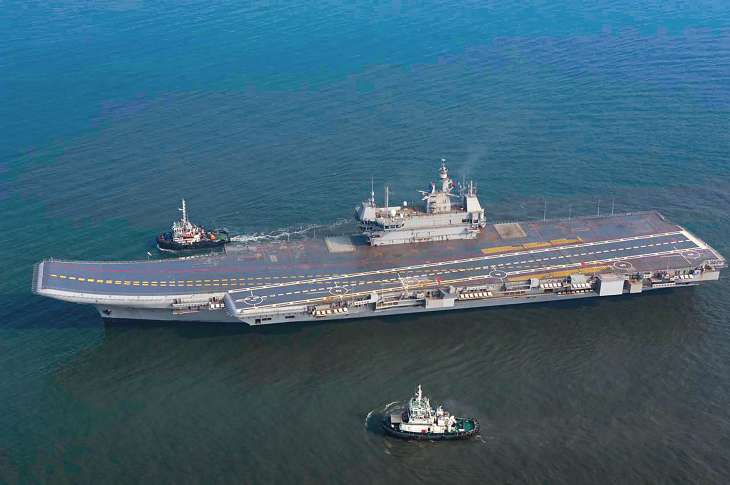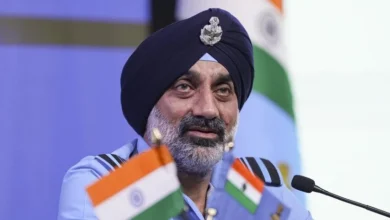Why China is worried about India’s indigenous aircraft carrier INS Vikrant

- The advanced surveillance radar on India's new battleship transmits target information to the ship's gunnery firing systems.
- Rocket launchers, torpedo launchers, and ASW helicopters that were developed domestically are used for anti-submarine warfare.
The Cochin Shipyard, the country’s first homegrown shipyard, delivered the INS Vikrant to India. The ship will probably be commissioned on August 15 in conjunction with India’s Independence Day.
The Indian Navy described the delivery of the warship as a “momentous day in the Indian maritime history and indigenous shipbuilding” following thorough user acceptance trials. The largest warship ever constructed in India weighs 21,500 tonnes of steel and has a deep displacement of 45,000 tonnes.
The fourth and last phase of sea testing for the $2.9 billion aircraft carrier were successfully completed three weeks ago. India has now joined a small group of countries that are able to design and construct an aircraft carrier domestically.
The INS Vikrant will fly MH-60R multi-role helicopters, Kamov-31 helicopters, and MiG-29K fighter jets. It features more than 2,300 compartments, including specialised quarters for female officers, built for a crew of about 1,700 people.
The newest warship built by India can travel for around 7,500 nautical miles at a maximum speed of about 28 knots and a cruise speed of 18 knots. The IAC measures 262 metres in length, 62 metres in width, and 59 metres in height. The warship’s construction started in 2009, and it was apparently delivered earlier than expected.
The aircraft carrier, according to the Navy, will strengthen India’s posture in the Indian Ocean Region (IOR) and advance its pursuit of a blue sea Navy after it was commissioned into the force.
The Navy stated that Vikrant was created with a high level of automation for machinery operation, ship navigation, and survivability and was made to fit a variety of fixed wing and rotary aircraft. The warship’s impending departure has been a major boost for India’s effort to become “Aatma Nirbhar Bharat” (an independent India).
The vessel would help India’s desire for a blue sea Navy and strengthen its standing in the Indian Ocean Region (IOR).
The battleship was given its name in honour of her legendary forebear, India’s first aircraft carrier, which was instrumental in the war of 1971. The 262-metre-long carrier, which is powered by four gas turbines with a combined 88 MW power, is far longer and more sophisticated than its predecessor.
The Ministry of Defense (MoD) and CSL agreed to three phases of the project, each of which was completed in May 2007, December 2014, and October 2019.
The INS Vikrant is equipped with the Short Take-Off but Arrested Landing system, which consists of a ski-jump for launching aircraft and a series of “arrester wires” for their recovery onboard after they land. It can operate with 30 aircraft.
Through a collaboration between the Navy, DRDO, and Steel Authority of India (SAIL), the project also resulted in the creation and manufacturing of domestic warship-grade steel for the ship, enabling the nation to achieve warship steel self-sufficiency.
In fact, the Cochin shipyard has been awarded a contract to build six next-generation missile vessels (NGMV) for the Indian Navy in addition to currently building eight anti-submarine warfare shallow water craft (ASWSWC).
The warship started its sea trials in August of last year. It is anticipated to complete flying tests using a ski-jump in a STOBAR configuration next year. For the Indian Navy, which hopes to keep China at distant in the tense Pacific waterways, it is a significant accomplishment.
Before the end of 2022, the INS Vikrant would be completely operational, according to Chief of Naval Staff Admiral Karambir Singh. With INS Visakhapatnam being a part of its armament, it represents a significant advantage for the Indian Navy.
The advanced surveillance radar on India’s new battleship transmits target information to the ship’s gunnery firing systems.
Rocket launchers, torpedo launchers, and ASW helicopters that were developed domestically are used for anti-submarine warfare.
Additionally, the ship is prepared for NBC (nuclear, biological, and chemical) warfare.
INS Visakhapatnam’s manufacturing incorporates a significant degree of indigenization.
Combat management system, rocket launcher, torpedo tube launcher, integrated platform management system, automated power management system, foldable hangar doors, Helo traversing system, close-in weapon system, and bow mounted Sonar are a few of the major indigenous equipment systems onboard INS Visakhapatnam.







Facebook Comments